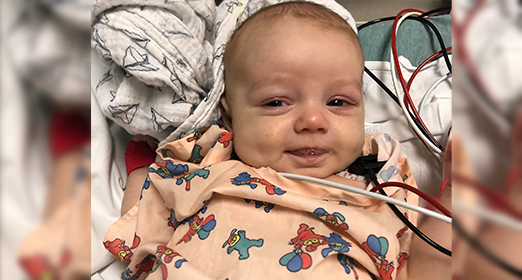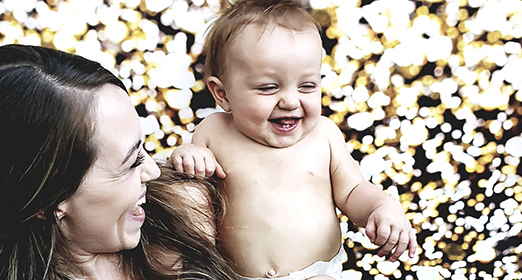Bucky loves dancing, watching “Teletubbies,” and playing with anything with wheels,” his mom, Anna Greunke says. “He’s just so happy all of the time.”
But when Bucky was 2 weeks old, Anna knew that something wasn’t quite right. At first, Bucky was happy and active. “Then I had a weird feeling,” she says. “He was losing weight even though he was eating great. It didn’t make sense.”
Anna brought Bucky to his pediatrician, who recommended that they transfer him to a bigger hospital that was close to their hometown of Patterson. When they arrived, a doctor told Anna he suspected Bucky had a rare, life-threatening liver condition called biliary atresia. Babies born with biliary atresia have no connection between their liver and small bowel, which causes bile to back up and destroy the liver.
Bucky’s doctors planned to take a biopsy of his liver and wait two weeks for results. Then they would consider doing a specialized surgery, called a Kasai procedure, to route the bile out of the liver.
Over the next few days, Anna could see that Bucky wasn’t doing well. As luck would have it, her friend worked as a nurse on Lucile Packard Children’s Hospital Stanford’s pediatric liver transplant unit, and Anna reached out for advice. “She told me that I really shouldn’t wait two weeks,” Anna says.
A Critical Window
Anna transferred Bucky to Packard Children’s Hospital right away. When they arrived at midnight, a surgeon met them and discussed next steps. “The timing of the procedure is critical,” says pediatric hepatologist Leina Alrabadi, MD. If the Kasai is performed within the first 45 days of life, the surgery has a much better chance of restoring bile flow and lessening the damage to the liver.
A multidisciplinary team of specialists in pediatric hepatology, surgery, interventional radiology, and nursing sprang into action. Bucky had the procedure three days later when he was just 33 days old, becoming the youngest patient to have the Kasai procedure at Packard Children’s.
A Promising Tomorrow
Fortunately, Bucky’s surgery was a success. While the Kasai procedure is not a cure for biliary atresia, Bucky will be able to keep his native liver longer and potentially avoid a future transplant.
He is now 18 months old, and his liver is working great. He is down to taking only one medication, and he returns to Packard Children’s Hospital every three months for checkups. His care team stays in close touch with Anna and their local doctors to ensure that his bloodwork remains normal and his development and growth are on track.
Your Support at Work
Anna says she has felt supported “every step of the way” by Bucky’s amazing care team and donors like you. Your gifts to the Children’s Fund support essential resources like social workers, child life specialists, and many others who help families through the hardships of hospitalization, enabling them to focus on what matters most.
“Without donors, I don’t think we could’ve stayed with Bucky in the hospital,” says Anna. “I don’t think we would’ve been able to have that level of care for him. You make it possible for kids to live.”
Jodi Mouratis contributed to this story.
This article originally appeared in the Spring 2021 issue of the Children’s Fund Update.

